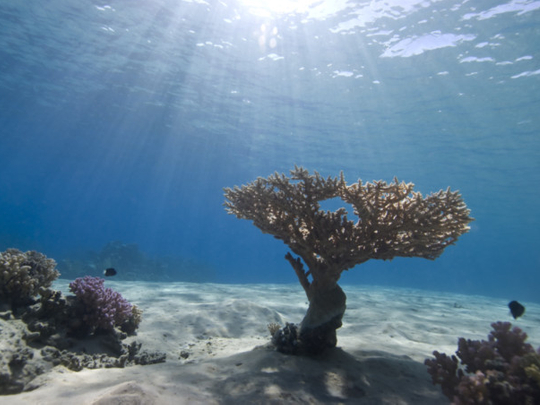
This is the last frontier: the ocean floor, 4,000 metres beneath the waters of the central Pacific, where mining companies are now exploring for the rich deposits of ores needed to keep industry humming and smartphones switched on.
The prospect of a race to the bottom of the ocean, a 21st-century high seas version of the Klondike gold rush, has alarmed scientists. The oceans make up 45 per cent of the world’s surface. They are already degraded by overfishing, industrial waste, plastic debris and climate change, which is altering their chemistry. Now comes a new extractive industry and scientists say governments are not prepared.
“It’s like a land grab,” says Sylvia Earle, an oceanographer and explorer-in-residence for National Geographic. “It’s a handful of individuals who are giving away or letting disproportionate special interests have access to large parts of the planet that just happen to be under water.”
The vast expanses of the central Pacific seabed being opened up for mining are still largely an unknown, she says. “What are we sacrificing by looking at the deep sea with dollar signs on the few tangible materials that we know are there? We haven’t begun to truly explore the ocean before we have started aiming to exploit it.”
But the warnings may arrive too late. The price of metals is rising. The ore content of the nodules of copper, manganese, cobalt and rare earths strewn across the ocean floor promise to be ten times greater than the richest seams on land, making the cost of their retrieval from the extreme depths more attractive to companies.
Mining the ocean floor of the central Pacific on a commercial scale is five years away, but the beginnings of an underwater gold rush are under way. The number of companies seeking to mine beneath international waters has tripled in the last three or four years. “We have already got a gold rush, in a way,” says Michael Lodge, Deputy Secretary General of the International Seabed Authority, which regulates the use of the sea floor in international waters. “The amount of activity has expanded exponentially.”
The Jamaica-based agency has granted 26 permits to date to explore an area the size of Mexico beneath the central Pacific that had been set aside for seabed mining — all but eight within the past three or four years. Britain is leading the way in a project led by Lockheed Martin, but Russia, China, Japan, and South Korea all have projects in play. This year alone, companies from Brazil, Germany and the Cook Islands have obtained permits to explore tracts of up to 75,000 square kilometres on the ocean floor for copper, cobalt, nickel and manganese, and the rare earth metals that help power smartphones, tablets and other devices. Other areas of the Pacific outside international waters are also opening up for mining, including sites off Papua New Guinea.
Lodge expects the pace to continue, with rising demand for metals for emerging economies, and for technologies such as hybrid cars and smartphones. Extracting the metals will not require drilling. The ore deposits are in nodules strewn across the rolling plains of sediment that carpet the ocean floor. Oceanographers say they resemble knobbly black potatoes, ranging in size from a couple of centimetres to 30 centimetres. Mining companies say it may be possible to scoop them up with giant tongs and then siphon them up to vessels waiting on the surface.
The problem is much remains unknown — not just about what exists on the ocean floor but how ocean systems operate to keep the planet habitable. The ocean floor was once thought to be a marine desert, but oceanographers say the sediment is rich in marine life, with thousands of species of invertebrates at a single site. “It’s tampering with ecosystems we hardly understand that are really at the frontier of our knowledge base,” says Greg Stone, vice-president for Conservation International. “We are starting mining extracting operations in a place where we don’t fully understand how it works yet. So that is our concern — disturbing the deep-sea habitat.”
Craig Smith, an oceanographer at the University of Hawaii who served as an adviser to the International Seabed Authority, says mining would damage vast areas of the sea floor. “I just don’t see any way [in] mining one of these claims that whole areas won’t be heavily damaged.”
Earle expressed fears about how mining companies will deal with waste in the high seas. “Mining is possible,” she says. “But the 20,000-foot question is what do you do with the tailings? All of the proposals involved dumping the tailings at sea with profound impacts on the water column and the sea floor below. The Seabed Authority initially proposed to set aside 1.6m square kilometres of the ocean floor as protected areas, or about 20 per cent of its territory. But those reserves are under review.”
Some have argued that with all the unknowns there should be no mining at all and that the high seas should remain out of bounds for mineral extraction and for shipping.
World leaders are now mobilising to address concerns, not just about seabed mining, but about how to safeguard ocean systems, which are increasingly recognised as critical to global food security and a healthy planet. US Secretary of State John Kerry recently invited leaders to a two-day summit in Washington that will seek ways of protecting fishing stocks from overexploitation and protecting the ocean from industrial pollution, plastic debris and the ravages of climate change.
The stakes have never been higher, say scientists.
— Guardian News and Media












